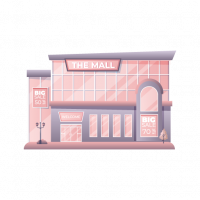Digital Mirrors | Enhancing | Retail Customer Experience | Elyts

In the dynamic landscape of retail, technology continues to reshape how customers interact with brands and products. One of the most innovative tools gaining traction is the digital mirror. Unlike traditional mirrors, digital mirrors offer an interactive, augmented reality (AR) experience that transforms shopping into a tech-savvy and personalized journey.
What Are Digital Mirrors?
Digital mirrors are technologically advanced screens that
function as mirrors while integrating AR to enhance the reflection with virtual
elements. Typically used in retail stores, these mirrors allow customers to
virtually try on clothes, accessories, or makeup without physically changing.
They use sensors and cameras to capture the customer's image, then overlay
digital versions of products onto the reflection in real time.
Key Features of Digital Mirrors
- Virtual
Try-Ons: Shoppers can see how outfits look without physically wearing
them.
- Personalization:
The mirrors can recommend outfits based on preferences and past purchases.
- Social
Sharing: Customers can capture images and share them on social media
directly from the mirror interface.
- Touchless
Interaction: Many digital mirrors feature gesture control, enhancing
hygiene and accessibility.
- Inventory
Integration: They can display stock availability and suggest matching
items.
How Digital Mirrors Enhance Customer Experience
1. Convenience and Efficiency
Digital mirrors save time by allowing customers to try
multiple outfits virtually. This reduces the need to carry and change clothes
frequently, making shopping more enjoyable and efficient.
2. Personalization at Its Best
By leveraging customer data and preferences, digital mirrors
suggest outfit combinations that align with individual tastes. This tailored
approach makes the shopping experience feel more exclusive.
3. Improved Engagement
The interactive nature of digital mirrors attracts customers
and keeps them engaged longer. The ability to share looks on social media also
fosters brand interaction.
4. Enhanced Decision-Making
Virtual try-ons minimize the uncertainty of buying fashion
items. Seeing how a product fits without wearing it helps customers make more
confident purchases.
Real-World Applications
Renowned brands like Nike, Sephora, and Ralph Lauren are
pioneering digital mirror technology to create immersive retail spaces. From
virtual makeup testing to styling assistance, these mirrors have become a
hallmark of modern retail innovation.
Challenges and Considerations
Despite their benefits, digital mirrors come with
challenges, including data privacy concerns and the high cost of
implementation. Retailers must ensure robust security and maintain transparency
regarding data usage.
The Future of Digital Mirrors in Retail
As AR technology advances, digital mirrors will become more
intuitive and affordable. Integrating AI for even more personalized
recommendations will further enhance their impact on customer satisfaction.
Conclusion
Digital mirrors are revolutionizing the retail landscape by
merging technology with the shopping experience. They not only improve
convenience and personalization but also foster stronger customer engagement.
As more brands adopt this innovation, the future of retail looks increasingly
digital and customer-centric.
Elyts Advertising and Branding Solutions | www.elyts.in (India) | www.elyts.agency (UAE)






















Leave a Comment